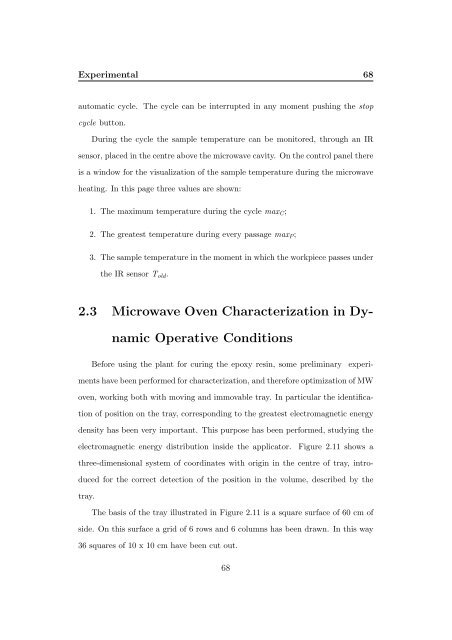Kinetic Analysis and Characterization of Epoxy Resins ... - FedOA
Kinetic Analysis and Characterization of Epoxy Resins ... - FedOA
Kinetic Analysis and Characterization of Epoxy Resins ... - FedOA
Create successful ePaper yourself
Turn your PDF publications into a flip-book with our unique Google optimized e-Paper software.
Experimental 68<br />
automatic cycle. The cycle can be interrupted in any moment pushing the stop<br />
cycle button.<br />
During the cycle the sample temperature can be monitored, through an IR<br />
sensor, placed in the centre above the microwave cavity. On the control panel there<br />
is a window for the visualization <strong>of</strong> the sample temperature during the microwave<br />
heating. In this page three values are shown:<br />
1. The maximum temperature during the cycle max C ;<br />
2. The greatest temperature during every passage max P ;<br />
3. The sample temperature in the moment in which the workpiece passes under<br />
the IR sensor T old .<br />
2.3 Microwave Oven <strong>Characterization</strong> in Dynamic<br />
Operative Conditions<br />
Before using the plant for curing the epoxy resin, some preliminary<br />
experiments<br />
have been performed for characterization, <strong>and</strong> therefore optimization <strong>of</strong> MW<br />
oven, working both with moving <strong>and</strong> immovable tray. In particular the identification<br />
<strong>of</strong> position on the tray, corresponding to the greatest electromagnetic energy<br />
density has been very important. This purpose has been performed, studying the<br />
electromagnetic energy distribution inside the applicator.<br />
Figure 2.11 shows a<br />
three-dimensional system <strong>of</strong> coordinates with origin in the centre <strong>of</strong> tray, introduced<br />
for the correct detection <strong>of</strong> the position in the volume, described by the<br />
tray.<br />
The basis <strong>of</strong> the tray illustrated in Figure 2.11 is a square surface <strong>of</strong> 60 cm <strong>of</strong><br />
side. On this surface a grid <strong>of</strong> 6 rows <strong>and</strong> 6 columns has been drawn. In this way<br />
36 squares <strong>of</strong> 10 x 10 cm have been cut out.<br />
68
















